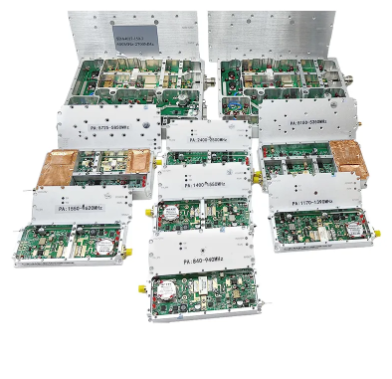Understanding the Complex World of RF Power Amplification
RF power amplifiers represent critical components in modern wireless communication systems, radar applications, and high-frequency electronic devices. As technology continues to advance and demand for higher frequencies increases, these essential components face numerous technical hurdles that engineers must overcome. The intricate balance between power output, efficiency, linearity, and thermal management becomes increasingly challenging as frequencies push into the gigahertz range and beyond.
The wireless industry's relentless pursuit of higher data rates and broader bandwidth capabilities has placed unprecedented demands on RF power amplifiers. From 5G infrastructure to satellite communications, these devices must deliver exceptional performance while managing various technical constraints. Understanding these challenges is crucial for engineers and system designers working to develop next-generation wireless solutions.

Fundamental Technical Barriers in High-Frequency Operation
Efficiency and Power Output Trade-offs
One of the most significant challenges RF power amplifiers face at high frequencies is maintaining acceptable efficiency levels while delivering the required power output. As frequencies increase, parasitic effects become more pronounced, leading to increased power losses and reduced efficiency. The traditional Class-A amplifiers, while offering excellent linearity, typically operate at efficiency levels below 25% at high frequencies, which is far from ideal for modern applications.
The pursuit of higher efficiency has led to the development of various amplifier classes and architectures, such as Class-F and inverse Class-F designs. However, these advanced topologies become increasingly difficult to implement as frequency increases due to the challenges in creating proper harmonic terminations and maintaining ideal waveforms at the device terminals.
Thermal Management Complexities
High-frequency operation of RF power amplifiers generates significant heat, which must be effectively dissipated to prevent performance degradation and ensure device reliability. The compact size requirements of modern systems further complicate thermal management, as smaller form factors limit the available surface area for heat dissipation. Advanced cooling solutions, such as micro-channel liquid cooling or advanced thermal interface materials, become necessary but add complexity and cost to the overall system.
The thermal challenges become particularly acute in applications requiring continuous wave (CW) operation or high duty cycle signals. The concentrated heat generation in small semiconductor areas can create hotspots that significantly impact device performance and longevity.
Signal Integrity and Linearity Considerations
Bandwidth and Linearity Constraints
Modern communication systems employ complex modulation schemes that require RF power amplifiers to maintain high linearity across wide bandwidths. This becomes increasingly challenging at higher frequencies, where device parasitic effects and package resonances can significantly impact the amplifier's frequency response. The need for wider bandwidth operation often conflicts with the goal of maintaining high efficiency, forcing designers to make careful trade-offs.
Memory effects and signal distortion become more pronounced at high frequencies, requiring sophisticated linearization techniques such as digital predistortion (DPD). However, implementing effective DPD becomes more challenging as bandwidth increases, due to the computational complexity and speed requirements of the digital processing systems.
Phase Noise and Stability Issues
Phase noise performance becomes increasingly critical in high-frequency applications, particularly in communication systems and radar applications. RF power amplifiers can contribute to phase noise degradation through various mechanisms, including thermal noise, flicker noise, and nonlinear effects. Maintaining low phase noise while delivering high power output presents a significant design challenge.
Stability considerations also become more complex at high frequencies, where parasitic oscillations and feedback paths can lead to unwanted oscillations or performance degradation. Careful attention to layout, biasing networks, and stabilization techniques becomes essential for reliable operation.
Manufacturing and Cost Implications
Process Technology Limitations
The fabrication of RF power amplifiers for high-frequency applications requires advanced semiconductor processes and materials. As frequencies increase, the choice of semiconductor technology becomes more limited, with options like Gallium Nitride (GaN) and Silicon Carbide (SiC) becoming necessary for high-power applications. These advanced materials, while offering superior performance, come with higher costs and more complex manufacturing processes.
The precision required in manufacturing high-frequency RF power amplifiers also impacts yield rates and production costs. Tight tolerances must be maintained in both the semiconductor fabrication and packaging processes to ensure consistent performance at high frequencies.
Integration and Packaging Challenges
As frequencies increase, packaging and integration become critical factors in overall amplifier performance. Traditional packaging technologies may introduce excessive parasitic effects or limit the achievable bandwidth. Advanced packaging solutions, such as air-cavity packages or integrated passive devices, become necessary but add to the overall cost and complexity.
The integration of RF power amplifiers with other system components also presents challenges at high frequencies. Issues such as electromagnetic interference (EMI), signal isolation, and thermal interaction between components must be carefully managed through proper design and layout techniques.
Frequently Asked Questions
How do RF power amplifiers handle the efficiency-linearity trade-off at high frequencies?
RF power amplifiers employ various techniques to balance efficiency and linearity at high frequencies, including advanced amplifier classes, envelope tracking, and Doherty architectures. These solutions often combine multiple approaches and may utilize digital predistortion to maintain linearity while optimizing efficiency.
What role does semiconductor choice play in high-frequency RF power amplifier performance?
The choice of semiconductor material significantly impacts high-frequency performance. Advanced materials like GaN and SiC offer superior power density and frequency capability compared to traditional Silicon, though at higher cost. The semiconductor selection influences key parameters including power output, efficiency, and thermal performance.
How are thermal management challenges addressed in modern RF power amplifiers?
Thermal management in modern RF power amplifiers involves multiple approaches, including advanced packaging techniques, integrated thermal management solutions, and sophisticated cooling systems. Design considerations may include the use of diamond heat spreaders, micro-channel cooling, and optimized thermal interface materials to maintain proper operating temperatures.

 EN
EN






